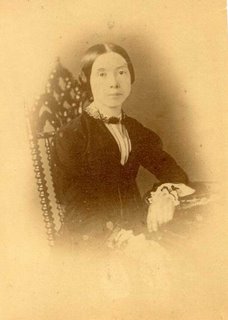
This following blurb about Emily Dickinson was on the Writer's Almanac this morning.
Emily Dickinson, was born in Amherst, Massachusetts (1830). She grew up at a time when people in New England were beginning to struggle with religion. Many had fallen away from the traditional Puritan faith, and so a religious revival movement was sweeping the area, bringing people back to the church. Dickinson remained agnostic, even after her father and sister experienced a conversion at a revival meeting in 1850, when Dickinson was twenty years old. She wrote in a letter, "Christ is calling everyone here, all my companions have answered, even my darling [sister] believes she loves, and trusts [Jesus], and I am standing alone in rebellion.
She moved back into her parents house to take care of the family household while her mother recovered from a nervous breakdown. She was not happy about the arrangement. She enjoyed gardening, but she hated to clean and absolutely refused to dust. What she disliked most of all about her father's house was the many visitors. Her father was one of the most prominent men in town, and people stopped by every day to talk politics, to get legal advice, and just to pay tribute. Dickinson thought the topics of conversation among her father's friends were always tedious, and she found the job of hosting constant visitors to be utterly exhausting.
As Dickinson took care of her family household, she watched as her friends get married and moved away. She grew increasingly isolated from her community, in no small part because she didn't attend church. In a letter to an acquaintance she wrote, "You ask of my companions. Hills, sir, and the sundown, and a dog large as myself, that my father bought me. They are better than beings because they know, but do not tell... I have a brother and sister; my mother does not care for thought, and my father, too busy with his [legal] briefs to notice what we do."
She wrote on scraps of paper and old grocery lists, compiled her poetry and tucked it away neatly in her desk drawer. After a few years of writing, she began collecting her hand-written poems into packets of folded paper, stitching the spines herself. She often included poems in her numerous letters to friends.
Dickinson eventually wrote more than 1,700 poems, most of them composed during the Civil War. She wrote 366 poems in 1862 alone, about one per day. Only seven of all her poems were published in her lifetime. Her sister Lavinia found the huge stash of the rest of her poems after Dickinson's death, but they were heavily edited when they finally came out in 1890. For a while, Dickinson was considered an interesting minor poet. It wasn't until 1955 that a more complete edition of her poetry was published, with the original punctuation intact. She's now considered the first great American lyric poet.
She wrote, "To live is so startling it leaves little time for anything else."

1 comment:
Until reading this post, I had never seen a photograph of Emily Dickinson. She actually does look like she never left the house. She's one of the greatest writers who ever lived, and her story remains one of solid inspiration to everyone who fears their work might end up going no further than a desk drawer. Thanks for sharing!
Post a Comment